Spatial Analysis of Territorial Connectivity and Accessibility in the Province of Coclé in Panama
Abstract
1. Introduction
2. State of Knowledge
2.1. Development of Spatial Analysis through GIS
2.2. Application of GIS in Connectivity and Accessibility Analysis
- Road Network: Despite not being the sole purpose of the territorial structure, this represents the extent to which relationships and exchanges can take place within it, and its research approach involves not only distinguishing the availability of the network but also establishing its accessibility and connectivity as necessary conditions to achieve differentiation of its objectives and services [33].
- Road Condition: The condition of the road infrastructure affects the macroscopic parameters of volume, speed, and density considered in the study of traffic phenomena [34,35]; according to the geometric characteristics of the road, the condition of the pavement, and complementary works, users (drivers and pedestrians) will define their preferences when making any trip, which, in turn, will affect the behavior of vehicular and pedestrian flows, the speeds developed by vehicles, and the results of the analysis of the values obtained for the aforementioned parameters [36,37].
- Road Vulnerability: The susceptibility of the network to certain failures that may lead to a reduction in the level of traffic, service levels, and accessibility conditions [38].
- Connection Nodes: This is used to understand what levels of connectivity the road network has [39]. A failure on a leg at one node of the network will lead to an increase in travel time due to the need to use alternative routes for optimal routing [40]; this can also cause congestion problems and therefore have consequences in terms of the level of service and travel time [41].
- Spatial Configuration and Density: The spatial configuration and density of land use patterns play a significant role in connectivity and accessibility. Compact, mixed-use developments with a high density of residential, commercial, and recreational areas tend to enhance accessibility by reducing travel distances and providing proximity to amenities and services [42,43].
- Socio-economic Factors: Socio-economic factors, such as population distribution, income levels, and employment opportunities, can have a profound impact on connectivity and accessibility. Areas with a higher population density and economic activity tend to have better transportation options and connectivity [44,45,46].
- Policy and Planning: Government policies and planning decisions play a crucial role in shaping connectivity and accessibility. Transportation planning strategies, land use regulations, and investment in infrastructure projects all impact the connectivity and accessibility levels within a region [47,48].
3. Case Study
4. Methodology
4.1. Determination of the Working Scenario
4.2. Data Acquisition
4.2.1. GIS Development
4.2.2. Field Work for GIS Validation
4.3. Spatial Analysis
4.3.1. Territorial Quadrants
4.3.2. Spatial Distribution of Population Size and Facilities
4.3.3. Spatial Analysis of Territorial Connectivity Based on the Road Network Development
4.3.4. Spatial Analysis of Territorial Accessibility
5. Results
5.1. Territorial Quadrants
5.2. Population Size and Their Spatial Distribution
5.3. Spatial Analysis of Territorial Connectivity
5.4. Spatial Analysis of Territorial Accessibility
6. Discussion and Conclusions
Author Contributions
Funding
Institutional Review Board Statement
Informed Consent Statement
Data Availability Statement
Conflicts of Interest
References
- Anselin, L. The Future of Spatial Analysis in the Social Sciences. Geogr. Inf. Sci. 1999, 5, 67–76. [Google Scholar] [CrossRef]
- Malczewski, J. GIS-Based Land-Use Suitability Analysis: A Critical Overview. Prog. Plann. 2004, 62, 3–65. [Google Scholar] [CrossRef]
- Sahin, P. Analysis of Walkable Street Networks by Using the Space Syntax and GIS Techniques: A Case Study of Çankırı City. ISPRS Int. J. Geo-Inf. 2023, 12, 216. [Google Scholar] [CrossRef]
- Bey, A.; Díaz, A.S.P.; Maniatis, D.; Marchi, G.; Mollicone, D.; Ricci, S.; Bastin, J.F.; Moore, R.; Federici, S.; Rezende, M.; et al. Collect Earth: Land Use and Land Cover Assessment through Augmented Visual Interpretation. Remote Sens. 2016, 8, 807. [Google Scholar] [CrossRef]
- de Álvarez Montero, J.J.; Eslava Sarmiento, A. La logística Urbana, La Ciudad logística Y El Ordenamiento Territorial logístico. RTO 2017, 4, 21–40. Available online: https://revistas.sena.edu.co/index.php/RETO/article/view/605 (accessed on 30 May 2023).
- Mosadeghi, R.; Warnken, J.; Tomlinson, R.; Mirfenderesk, H. Comparison of Fuzzy-AHP and AHP in a Spatial Multi-Criteria Decision Making Model for Urban Land-Use Planning. Comput. Environ. Urban Syst. 2015, 49, 54–65. [Google Scholar] [CrossRef]
- Patino, J.E.; Duque, J.C. A Review of Regional Science Applications of Satellite Remote Sensing in Urban Settings. Comput. Environ. Urban Syst. 2013, 37, 1–17. [Google Scholar] [CrossRef]
- Jiang, R.; Wu, P. Estimation of Environmental Impacts of Roads through Life Cycle Assessment: A Critical Review and Future Directions. Transp. Res. D Transp. Environ. 2019, 77, 148–163. [Google Scholar] [CrossRef]
- Chen, N.; Cheng, G.; Yang, J.; Ding, H.; He, S. Evaluation of Urban Ecological Environment Quality Based on Improved RSEI and Driving Factors Analysis. Sustainability 2023, 15, 8464. [Google Scholar] [CrossRef]
- Iacono, M.; Levinson, D. The Economic Impact of Upgrading Roads; Minnesota Department of Transportation Research Services Section: St. Paul, MN, USA, 2009; pp. 1–75. Available online: https://www.lrrb.org/pdf/200916.pdf (accessed on 2 June 2023).
- Van Heerden, Q.; Karsten, C.; Holloway, J.; Petzer, E.; Burger, P.; Mans, G. Accessibility, affordability, and equity in long-term spatial planning: Perspectives from a developing country. Transp. Policy 2022, 120, 104–119. [Google Scholar]
- Chen, S.; Claramunt, C.; Ray, C. A Spatio-Temporal Modelling Approach for the Study of the Connectivity and Accessibility of the Guangzhou Metropolitan Network. J. Transp. Geogr. 2014, 36, 12–23. [Google Scholar] [CrossRef]
- Medeiros, E. Territorial Cohesion: An EU Concept. Eur. J. Spat. Dev. 2016, 1, 1–30. [Google Scholar]
- Calvo-Poyo, F.; Moya-Gómez, B.; García Palomares, J.C.; Gutiérrez Puebla, J. Efectos Sobre La Accesibilidad de La Red de Autovías Planeada En El Plan de Infraestructuras Para La Sostenibilidad Del Transporte En Andalucía (España). Cuad. Geogr. 2019, 58, 229–252. [Google Scholar] [CrossRef]
- Mohd Noor, N.; Abdullah, A.; Hashim, M. Remote Sensing UAV/Drones and Its Applications for Urban Areas: A Review. In IOP Conference Series: Earth and Environmental Science, Proceedings of the 9th IGRSM International Conference and Exhibition on Geospatial & Remote Sensing (IGRSM 2018), Kuala Lumpur, Malaysia, 24–25 April 2018; Institute of Physics Publishing: Bristol, UK, 2018; Volume 169. [Google Scholar] [CrossRef]
- Grubesic, T.H.; Nelson, J.R. UAVs and Urban Spatial Analysis; Springer: Cham, Switzerland, 2019; pp. 1–8. [Google Scholar] [CrossRef]
- Ministerio de Economía y Finanzas de la República de Panamá. Informe Económico y Social 2019. 2019. Available online: https://www.mef.gob.pa/wp-content/uploads/2023/05/MEF-DAES-Informe-Economico-y-Social-anual-2019.pdf (accessed on 2 June 2023).
- Vlčková, V.; Votruba, Z. The Synergy Transportation. Trans. Transp. Sci. 2010, 3, 179–186. [Google Scholar] [CrossRef]
- AC&A; Cenit. Análisis de Inversiones en el Sector Transporte Terrestre Interurbano Latinoamericano a 2040; CAF: Caracas, Venezuela, 2020; Available online: https://scioteca.caf.com/handle/123456789/1537 (accessed on 2 June 2023).
- Requejo Liberal, J.; Hernández Vergues, A.; Morilla Maestre, A.; Guerrero Sosa, J.; Macías Vivero, J.; Alonso Blanco, A.; Garrido Martín, A.; Rodríguez, F.; Barría, C.; Medina, M.; et al. Visión 2050 Diagnóstico. 2018. Available online: https://www.senacyt.gob.pa/publicaciones/?publicacion=vision-2050-cocle-diagnostico (accessed on 2 June 2023).
- Ito, M.; Okabe, D.; Anderson, K.; Research, I. Portable Objects in Three Global Citties: The Personalization of Urban Places; Routledge: London, UK, 2009. [Google Scholar]
- Labi, S.; Faiz, A.; Saeed, T.U.; Alabi, B.N.T.; Woldemariam, W. Connectivity, Accessibility, and Mobility Relationships in the Context of Low-Volume Road Networks. In Transportation Research Record; SAGE Publications Ltd.: Thousand Oaks, CA, USA, 2019; Volume 2673, pp. 717–727. [Google Scholar] [CrossRef]
- Abousaeidi, M.; Fauzi, R.; Muhamad, R. Geographic Information System (GIS) Modeling Approach to Determine the Fastest Delivery Routes. Saudi. J. Biol. Sci. 2016, 23, 555–564. [Google Scholar] [CrossRef]
- Cebrián Abellán, F.; Andrés López, G.; Bellet Sanfeliu, C. The Use of GIS and Multicriteria Techniques for the Socio-Spatial Analysis of Urban Areas in Medium-Sized Spanish Cities. Land 2023, 12, 1115. [Google Scholar] [CrossRef]
- Yang, Y.; Zhou, Q.; Chen, K. Multiagent-Based Modeling and Simulation of a Coal Multimodal Transport System. IEEE Access 2022, 10, 65873–65885. [Google Scholar] [CrossRef]
- Dhamaniya, A.; Sonu, M.; Krishnanunni, M.; Praveen, P.; Jaijin, A. Development of Web Based Road Accident Data Management System in GIS Environment: A Case Study. J. Indian Soc. Remote Sens. 2016, 44, 789–796. [Google Scholar] [CrossRef]
- Sreelekha, M.G.; Krishnamurthy, K.; Anjaneyulu, M.V.L.R. Interaction between Road Network Connectivity and Spatial Pattern. Procedia Technol. 2016, 24, 131–139. [Google Scholar] [CrossRef]
- Saidallah, M.; El Fergougui, A.; Elalaoui, A.E. A Comparative Study of Urban Road Traffic Simulators. In MATEC Web of Conferences, Proceedings of the 2016 5th International Conference on Transportation and Traffic Engineering (ICTTE 2016), Lucerne, Switzerland, 6–10 July 2016; EDP Sciences: Les Ulis, France, 2016; Volume 81. [Google Scholar] [CrossRef]
- Akberdina, V.; Kozonogova, E.; Dubrovskaya, Y. Digital Platforms for Regional Economic Research: A Review and Methodology Proposal. R-Economy 2023, 9, 52–72. [Google Scholar] [CrossRef]
- Menhas, R.; Mahmood, S.; Tanchangya, P.; Safdar, M.N.; Hussain, S. Sustainable Development under Belt and Road Initiative: A Case Study of China-Pakistan Economic Corridor’s Socio-Economic Impact on Pakistan. Sustainability 2019, 11, 6143. [Google Scholar] [CrossRef]
- Shi, F. Research on Accessibility and Equity of Urban Transport Based on Multisource Big Data. J. Adv. Transp. 2021, 2021, 1103331. [Google Scholar] [CrossRef]
- Jin, F.; Chen, Z. Evolution of Transportation in China since Reform and Opening up: Patterns and Principles. J. Geogr. Sci. 2019, 29, 1731–1757. [Google Scholar] [CrossRef]
- Bautista, A.F. Análisis de Accesibilidad y Conectividad de La Red Vial Intermunicipal En El Micro-Sistema Regional de La Provincia Centro En Boyacá, Colombia. Perspect. Geogr. 2018, 23, 123–141. [Google Scholar] [CrossRef]
- Leonardi, G.; Barrile, V.; Palamara, R.; Suraci, F.; Candela, G. 3D Mapping of Pavement Distresses Using an Unmanned Aerial Vehicle (UAV) System. In Smart Innovation, Systems and Technologies; Springer Science and Business Media: Berlin, Germany, 2019; Volume 101, pp. 164–171. [Google Scholar] [CrossRef]
- Droj, G.; Droj, L.; Badea, A.C. GIS-Based Survey over the Public Transport Strategy: An Instrument for Economic and Sustainable Urban Traffic Planning. ISPRS Int. J. Geoinf. 2022, 11, 16. [Google Scholar] [CrossRef]
- Quintero González, J. Road Inventories and the Road Net Categorization in the Traffic and Transport Engineering Studies. Rev. Fac. Ing. UPTC I Semest. 2011, 20, 65–77. Available online: https://revistas.uptc.edu.co/index.php/ingenieria/article/view/1413 (accessed on 2 June 2023).
- Yang, X.; Yuan, Y.; Liu, Z. Short-Term Traffic Speed Prediction of Urban Road with Multi-Source Data. IEEE Access 2020, 8, 87541–87551. [Google Scholar] [CrossRef]
- Berdica, K.; Mattsson, L.G. Vulnerability: A Model-Based Case Study of the Road Network in Stockholm. In Advances in Spatial Science; Springer International Publishing: Cham, Switzerland, 2007; pp. 81–106. [Google Scholar] [CrossRef]
- Mishra, S.; Welch, T.F.; Jha, M.K. Performance Indicators for Public Transit Connectivity in Multi-Modal Transportation Networks. Transp. Res. Part A Policy Pract. 2012, 46, 1066–1085. [Google Scholar]
- Jenelius, E.; Mattsson, L.G. Road Network Vulnerability Analysis: Conceptualization, Implementation and Application. Comput. Environ. Urban Syst. 2015, 49, 136–147. [Google Scholar] [CrossRef]
- Proffitt, D.G.; Bartholomew, K.; Ewing, R.; Miller, H.J. Accessibility Planning in American Metropolitan Areas: Are We There Yet? Urban Stud. 2019, 56, 167–192. [Google Scholar] [CrossRef]
- Li, M.; Stein, A.; Bijker, W.; Zhan, Q. Urban Land Use Extraction from Very High Resolution Remote Sensing Imagery Using a Bayesian Network. ISPRS J. Photogramm. Remote Sens. 2016, 122, 192–205. [Google Scholar] [CrossRef]
- Soltani, S.; Gu, N.; Ochoa, J.J.; Sivam, A. The Role of Spatial Configuration in Moderating the Relationship between Social Sustainability and Urban Density. Cities 2022, 121, 103519. [Google Scholar] [CrossRef]
- Zhao, C.; Nielsen, T.A.S.; Olafsson, A.S.; Carstensen, T.A.; Meng, X. Urban Form, Demographic and Socio-Economic Correlates of Walking, Cycling, and e-Biking: Evidence from Eight Neighborhoods in Beijing. Transp. Policy 2018, 64, 102–112. [Google Scholar] [CrossRef]
- Salemink, K.; Strijker, D.; Bosworth, G. Rural Development in the Digital Age: A Systematic Literature Review on Unequal ICT Availability, Adoption, and Use in Rural Areas. J. Rural. Stud. 2017, 54, 360–371. [Google Scholar] [CrossRef]
- Christodoulou, A.; Christidis, P. Bridges across Borders: A Clustering Approach to Support EU Regional Policy. J. Transp. Geogr. 2020, 83, 102666. [Google Scholar] [CrossRef]
- Attia, S.; Ibrahim, A.A.A.M. Accessible and Inclusive Public Space: The Regeneration of Waterfront in Informal Areas. Urban Res. Pract. 2018, 11, 314–337. [Google Scholar] [CrossRef]
- Rokem, J.; Vaughan, L. Geographies of Ethnic Segregation in Stockholm: The Role of Mobility and Co-Presence in Shaping the ‘Diverse’ City. Urban Stud. 2019, 56, 2426–2446. [Google Scholar] [CrossRef]
- Porru, S.; Misso, F.E.; Pani, F.E.; Repetto, C. Smart Mobility and Public Transport: Opportunities and Challenges in Rural and Urban Areas. J. Traffic Transp. Eng. 2020, 7, 88–97. [Google Scholar] [CrossRef]
- Mascarenhas, A.; Ramos, T.B.; Nunes, L. Developing an Integrated Approach for the Strategic Monitoring of Regional Spatial Plans. Land Use Policy 2012, 29, 641–651. [Google Scholar] [CrossRef]
- Bueno-Suárez, C.; Coq-Huelva, D. Sustaining What Is Unsustainable: A Review of Urban Sprawl and Urban Socio-Environmental Policies in North America and Western Europe. Sustainability 2020, 12, 4445. [Google Scholar] [CrossRef]
- Yu, M.; Yang, C.; Li, Y. Big Data in Natural Disaster Management: A Review. Geosciences 2018, 8, 165. [Google Scholar] [CrossRef]
- Deng, X.; Jin, G.; He, S.; Wang, C.; Li, Z.; Wang, Z.; Song, M.; Yang, Q.; Zhang, A.; Chen, J. Research Progress and Prospect on Development Geography. J. Geogr. Sci. 2021, 31, 437–455. [Google Scholar] [CrossRef]
- Bhadury, J. Panama Canal Expansion and Its Impact on East and Gulf Coast Ports of U.S.A. Marit. Policy Manag. 2016, 43, 928–944. [Google Scholar] [CrossRef]
- Granada Garcés, I.; Fioravanti, R.; Deambrosi, S.; Clara Gutiérrez, M.; Caldo, A.; Benavides, J.; Martínez, M.; Caldo, C.V.; Benavides, A.V.; Martínez, J., VII; et al. Evolución Del Sector Logístico y Apoyo Del BID En Panamá; Banco de Desarrollo Interamericano: Washington, DC, USA, 2018. [Google Scholar] [CrossRef]
- Porcel, M.R.; Fioravanti, R.; Martínez, M. Conectividad Vial y Su Contribución al Sistema Logístico de Panamá División de Transporte; Banco Interamericano de Desarrollo (BID): Washington, DC, USA, 2019. [Google Scholar] [CrossRef]
- Caja de Seguro Social. Análisis de Situación de la Prestación de la Salud y Económicas de la Caja de Seguro Social Provincia de Coclé. 2021. Available online: https://planificacion.css.gob.pa/wp-content/uploads/2021/12/Ana%CC%81lisis-de-Situacio%CC%81n-Cocle%CC%81.pdf (accessed on 2 June 2023).
- Instituto Nacional de Estadística y Censo. Estimación y Proyección de la Población Total de la Provincia de Coclé, Según Distrito, Co-rregimiento y Sexo: Años 2010–2020. 2010. Available online: https://www.inec.gob.pa/archivos/P5561Cuadro%2079.pdf (accessed on 2 June 2023).
- Quijada-Alarcon, J.; González Cancelas, N.; Camarero Orive, A.; Soler Flores, F. Logistic Groups in the Republic of Panama. J. Maps 2016, 12, 1248–1252. [Google Scholar] [CrossRef]
- Wingtra. WingtraOne Gen II Technical Specifications. 2023. Available online: https://wingtra.com/wp-content/uploads/Wingtra-Technical-Specifications.pdf (accessed on 2 June 2023).
- Felipe-García, B.; Hernández-López, D.; Lerma, J.L. Analysis of the Ground Sample Distance on Large Photogrammetric Surveys. Appl. Geomat. 2012, 4, 231–244. [Google Scholar] [CrossRef]
- Driggers, R.; Aghera, S.; Richardson, P.; Miller, B.; Doe, J.; Robinson, A.; Krapels, K.; Murrill, S. MWIR Persistent Surveillance Performance for Human and Vehicle Backtracking as a Function of Ground Sample Distance and Revisit Rate. In Infrared Imaging Systems: Design, Analysis, Modeling, and Testing XIX, Proceedings of the Spie Defense and Security Symposium, Orlando, FL, USA, 16–20 March 2008; SPIE: Stockholm, Sweden, 2008; Volume 6941, p. 69410Q. [Google Scholar] [CrossRef]
- Bartlett, B.D. Anomaly Detection with Varied Ground Sample Distance Utilizing Spectropolarimetric Imagery Collected Using a Liquid Crystal Tunable Filter. Opt. Eng. 2011, 50, 081207. [Google Scholar] [CrossRef]
- Gallacher, D. Drones to Manage the Urban Environment: Risks, Rewards, Alternatives. J. Unmanned Veh. Syst. 2016, 4, 115–124. [Google Scholar] [CrossRef]
- Rybansky, M.; Kratochvíl, V.; Dohnal, F.; Gerold, R.; Kristalova, D.; Stodola, P.; Nohel, J. GNSS Signal Quality in Forest Stands for Off-Road Vehicle Navigation. Appl. Sci. 2023, 13, 6142. [Google Scholar] [CrossRef]
- Catania, P.; Comparetti, A.; Febo, P.; Morello, G.; Orlando, S.; Roma, E.; Vallone, M. Positioning Accuracy Comparison of GNSS Receivers Used for Mapping and Guidance of Agricultural Machines. Agronomy 2020, 10, 924. [Google Scholar] [CrossRef]
- Zhang, H.; Aldana-Jague, E.; Clapuyt, F.; Wilken, F.; Vanacker, V.; Van Oost, K. Evaluating the Potential of Post-Processing Kinematic (PPK) Georeferencing for UAV-Based Structure-from-Motion (SfM) Photogrammetry and Surface Change Detection. Earth Surf. Dyn. 2019, 7, 807–827. [Google Scholar] [CrossRef]
- Pirti, A. Evaluating the Accuracy of Post-Processed Kinematic (PPK) Positioning Technique. Geod. Cartogr. 2021, 47, 66–70. [Google Scholar] [CrossRef]
- Department of Transport and Main Roads. Manual Trimble Business Center V5.40—Processing and Adjusting GNSS Survey Control Networks. 2021. Available online: https://www.tmr.qld.gov.au/_/media/busind/techstdpubs/surveying/surveying-support-documents/tbc/tbcmanual.pdf?sc_lang=en&hash=2CA967C6DB233B5614C153CC9377B572 (accessed on 2 June 2023).
- Agisoft. Agisoft Metashape User Manual Professional Edition, Version 2.0. 2023. Available online: https://www.agisoft.com/downloads/user-manuals (accessed on 2 June 2023).
- Esri. ArcGIS Pro Implementation Guide. 2021. Available online: https://www.esri.com/content/dam/esrisites/es-es/media/pdf/implementation-guides/arcgis-pro-implementation-guide.pdf (accessed on 2 June 2023).
- Liu, X.H.; Kyriakidis, P.C.; Goodchild, M.F. Population-Density Estimation Using Regression and Area-to-Point Residual Kriging. Int. J. Geogr. Inf. Sci. 2008, 22, 431–447. [Google Scholar] [CrossRef]
- Daniel, C.B.; Saravanan, S.; Mathew, S. GIS Based Road Connectivity Evaluation Using Graph Theory. In Lecture Notes in Civil Engineering; Springer: New York, NY, USA, 2020; Volume 45, pp. 213–226. [Google Scholar] [CrossRef]
- Perz, S.G.; Xia, Y.; Shenkin, A. Global Integration and Local Connectivity: Trans-Boundary Highway Paving and Rural-Urban Ties in the Southwestern Amazon. J. Lat. Am. Geogr. 2014, 13, 205–239. [Google Scholar] [CrossRef]
- Zhao, P.; Li, S.; Liu, D. Unequable Spatial Accessibility to Hospitals in Developing Megacities: New Evidence from Beijing. Health Place 2020, 65, 102406. [Google Scholar] [CrossRef] [PubMed]
- Boisjoly, G.; Deboosere, R.; Wasfi, R.; Orpana, H.; Manaugh, K.; Buliung, R.; El-Geneidy, A. Measuring Accessibility to Hospitals by Public Transport: An Assessment of Eight Canadian Metropolitan Regions. J. Transp. Health 2020, 18, 100916. [Google Scholar] [CrossRef]
- Burnett, S.; Lloyd, A. The Road Not Taken: Locating Desire Lines across Information Landscapes. In Proceedings of the 10th International Conceptions of Library and Information Science Conference (CoLIS 2019), Ljubljana, Slovenia, 16–19 June 2019; Available online: https://informationr.net/ir/24-4/colis/colis1911.html (accessed on 2 June 2023).
- Hashidu, B.R.; Abbas, A.M.; Hashidu, R.B. Transportation Network Analysis, Connectivity and Accessibility Indices in North East, Nigeria. J. Res. Humanit. Soc. Sci. 2019, 7, 60–66. Available online: https://www.questjournals.org/jrhss/papers/vol7-issue9/H07096066.pdf (accessed on 25 June 2023).
- Gómez, J.M.N.; Vulevic, A.; Couto, G.; Castanho, R.A. Accessibility in European Peripheral Territories: Analyzing the Portuguese Mainland Connectivity Patterns from 1985 to 2020. Infrastructures 2021, 6, 92. [Google Scholar] [CrossRef]
- Balsa-Barreiro, J.; Ambuühl, L.; Menéndez, M.; Pentland, A. Mapping Time-Varying Accessibility and Territorial Cohesion with Time-Distorted Maps. IEEE Access 2019, 7, 41702–41714. [Google Scholar] [CrossRef]
- Rekha, R.S.; Radhakrishnan, N.; Mathew, S. Spatial Accessibility Analysis of Schools Using Geospatial Techniques. Spat. Inf. Res. 2020, 28, 699–708. [Google Scholar] [CrossRef]
- Wolny, A.; Ogryzek, M.; Źróbek, R. Towards Sustainable Development and Preventing Exclusions-Determining Road Accessibility at the Sub-Regional and Local Level in Rural Areas of Poland. Sustainability 2019, 11, 4880. [Google Scholar] [CrossRef]
- Falih, K.T.; Alyaqoobi, A.M. Spatial Analysis of Educational Services Using GIS in Nasiriyah City. Turk. J. Comput. Math. Educ. 2021, 12, 1974–1984. [Google Scholar] [CrossRef]
- Blanford, J.I.; Kumar, S.; Luo, W.; MacEachren, A.M. It’s a Long, Long Walk: Accessibility to Hospitals, Maternity and Integrated Health Centers in Niger. Int. J. Health Geogr. 2012, 11, 24. [Google Scholar] [CrossRef] [PubMed]
- Mirad, A.A. Using Geographical Information Systems for Defining Accessibility to Health Care Facilities in Jeddah City. Geospat. Health 2014, 8, S661–S669. [Google Scholar] [CrossRef] [PubMed]
- Zegarra Méndez, E. Gestión Del Agua, Valoración y Desempeño Económico Del Canal de Panamá; Banco Interamericano de Desarrollo (BID): Washington, DC, USA, 2017. [Google Scholar] [CrossRef]
- Instituto Nacional de Estadística y Censo de Panamá. Producto Interno Bruto Provincial, a Precios Corrientes y en Medias de Volumen Encadenadas con año de Referencia 2007: Años 2017-20. 2021. Available online: https://www.inec.gob.pa/archivos/P053342420211123162346COMENTARIOS.pdf (accessed on 11 July 2023).
- Gabinete Logístico. Estrategia Logística Nacional de Panamá a 2030; Banco Interamericano de Desarrollo (BID). 2017. Available online: https://www.presidencia.gob.pa/pdfs/ELNP.pdf (accessed on 11 July 2023).
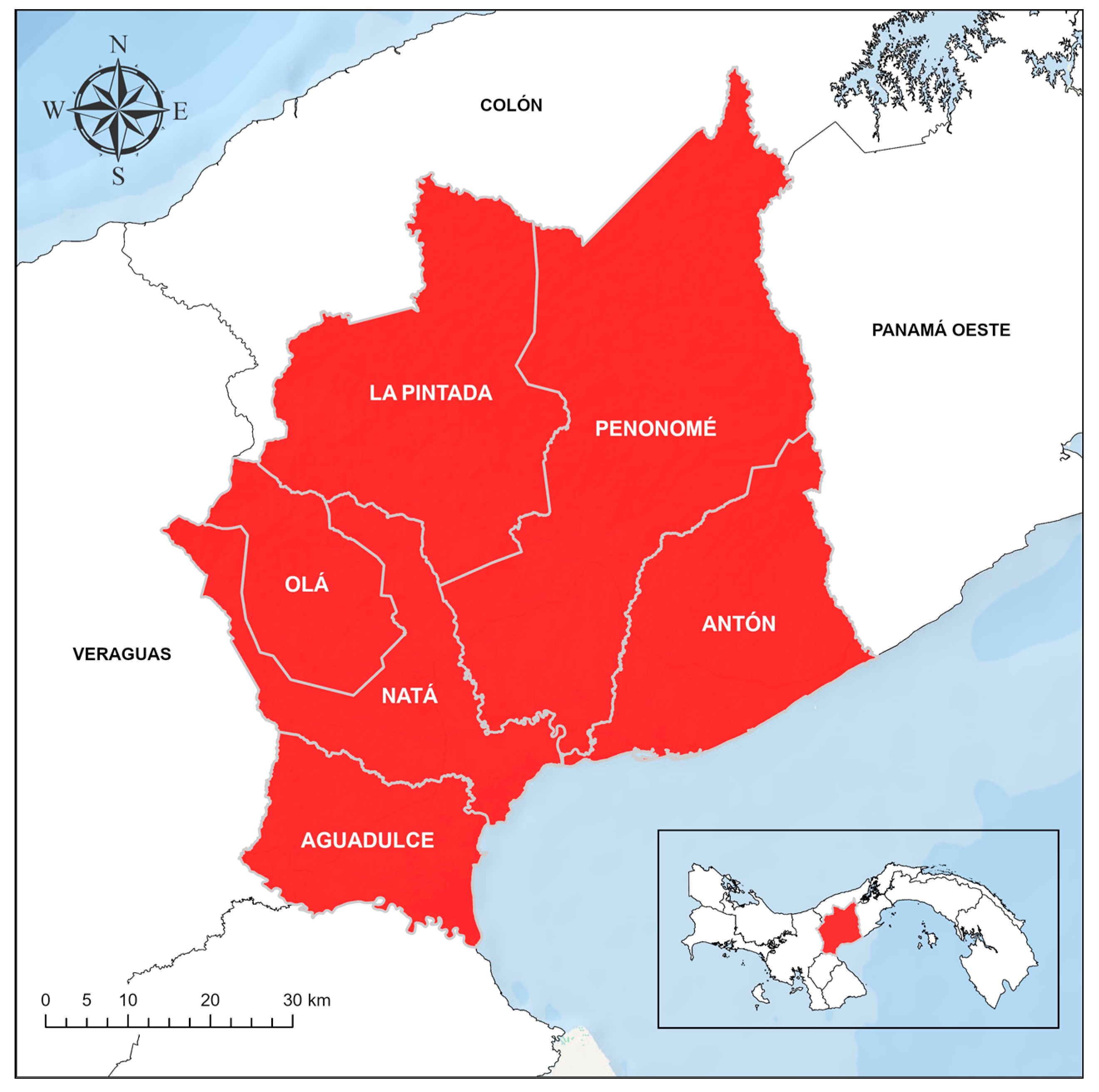
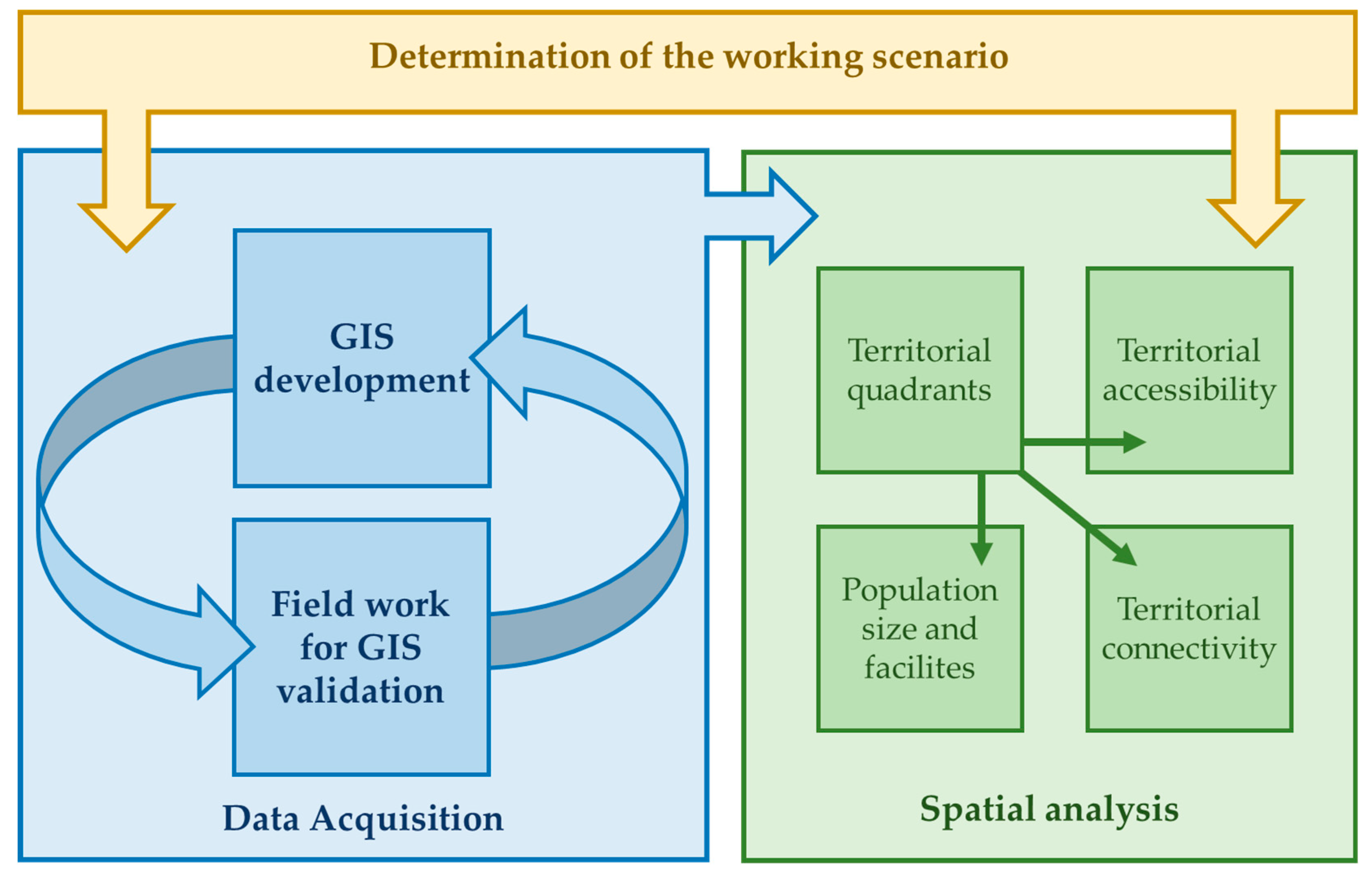
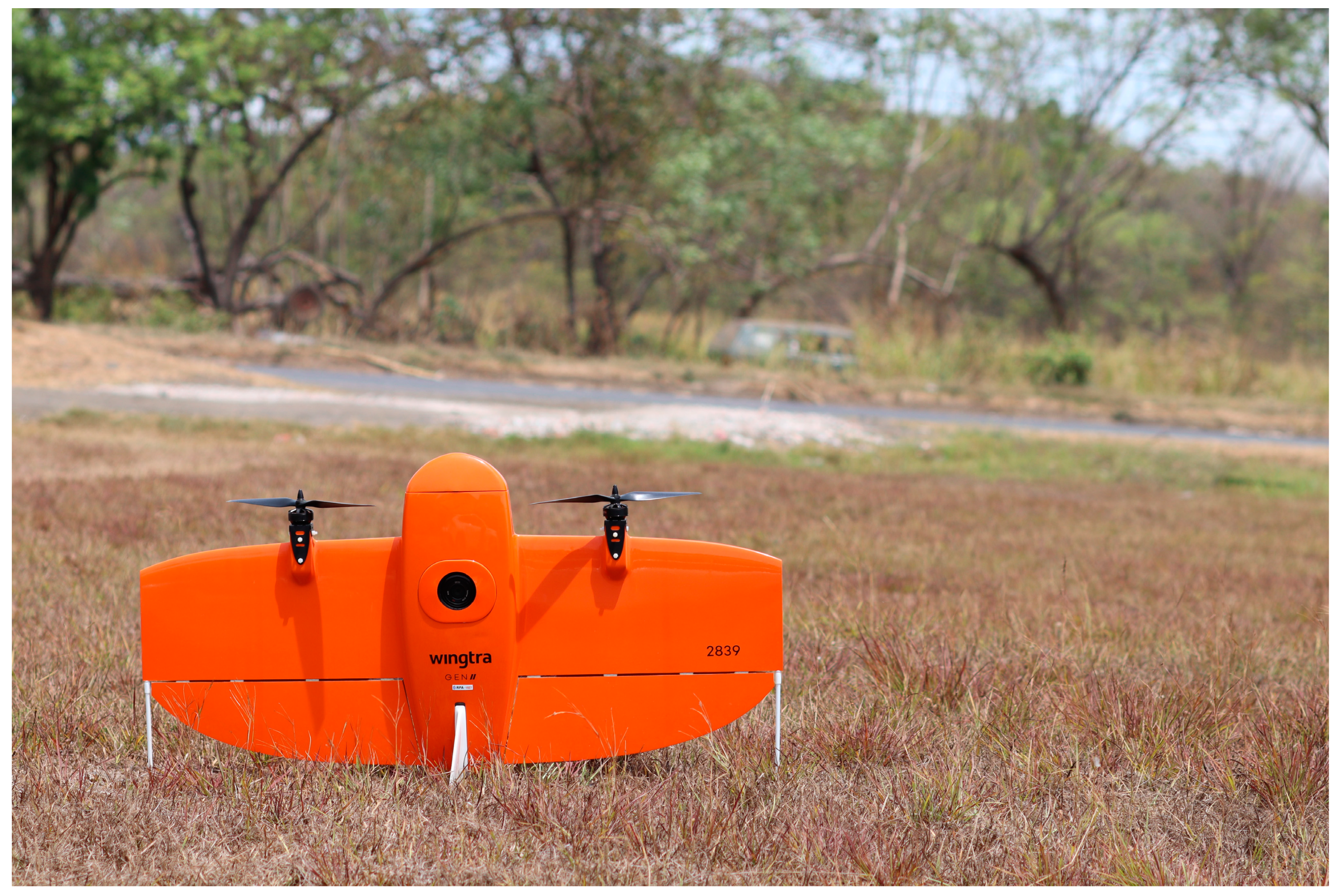

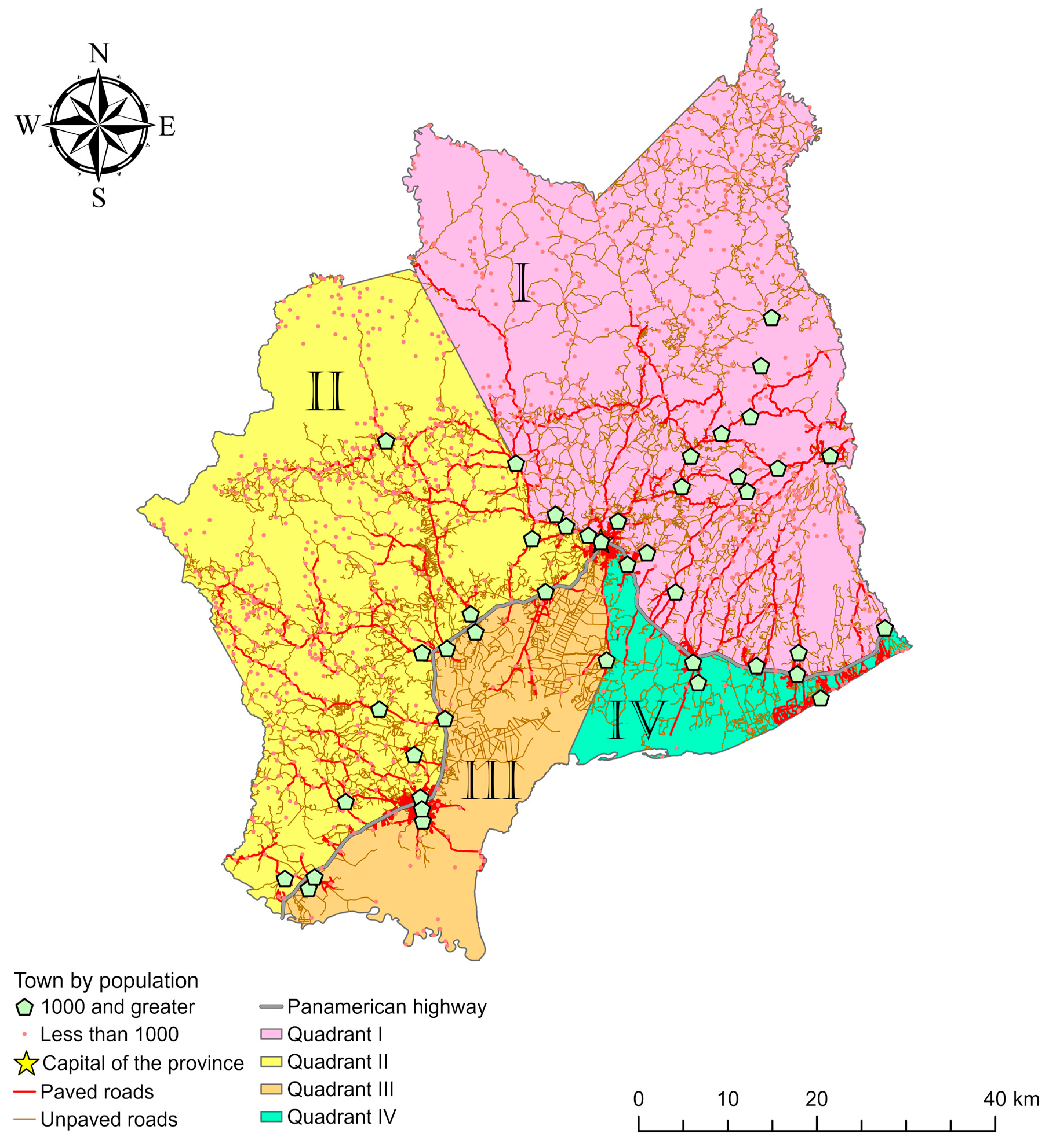

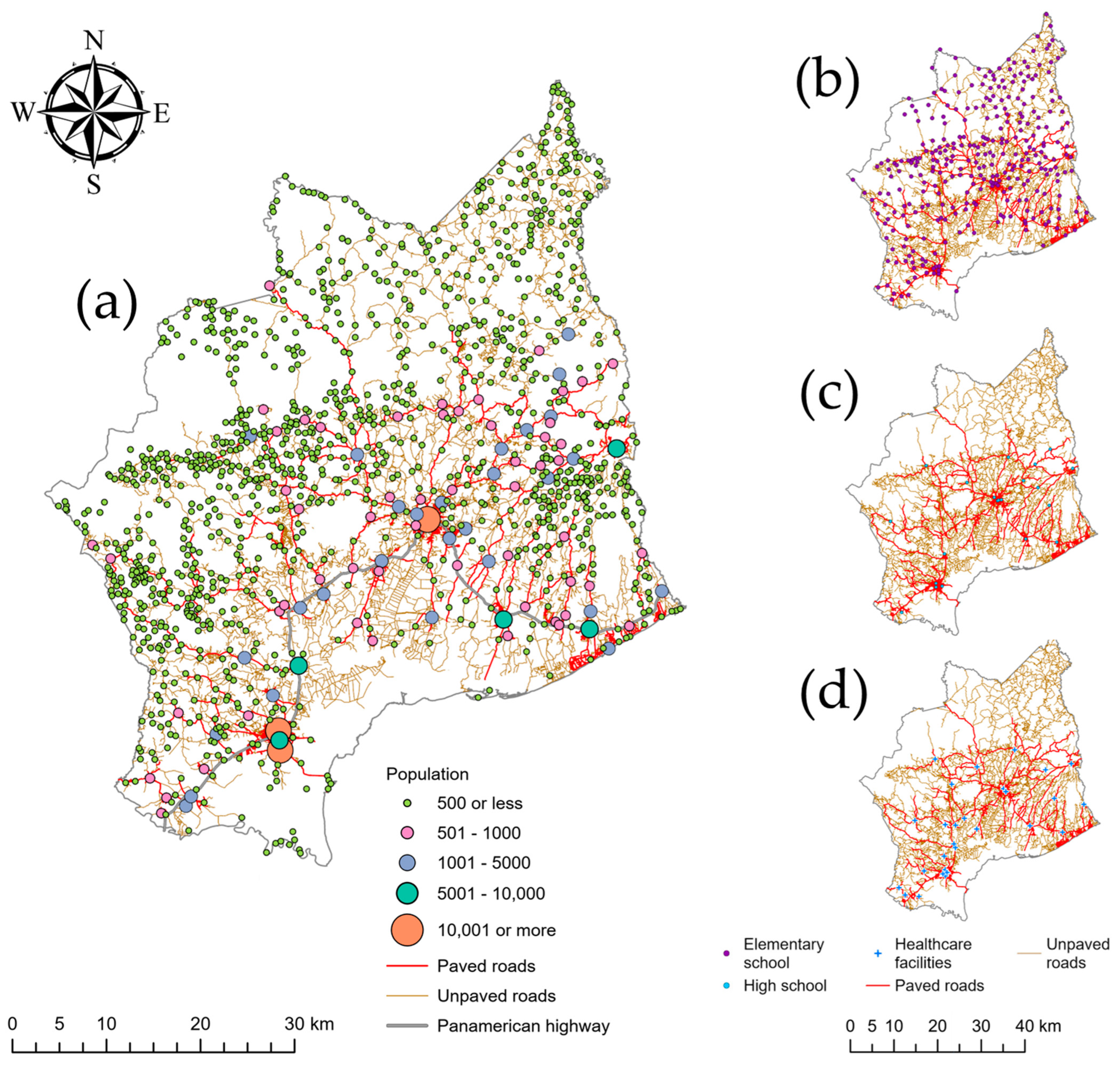


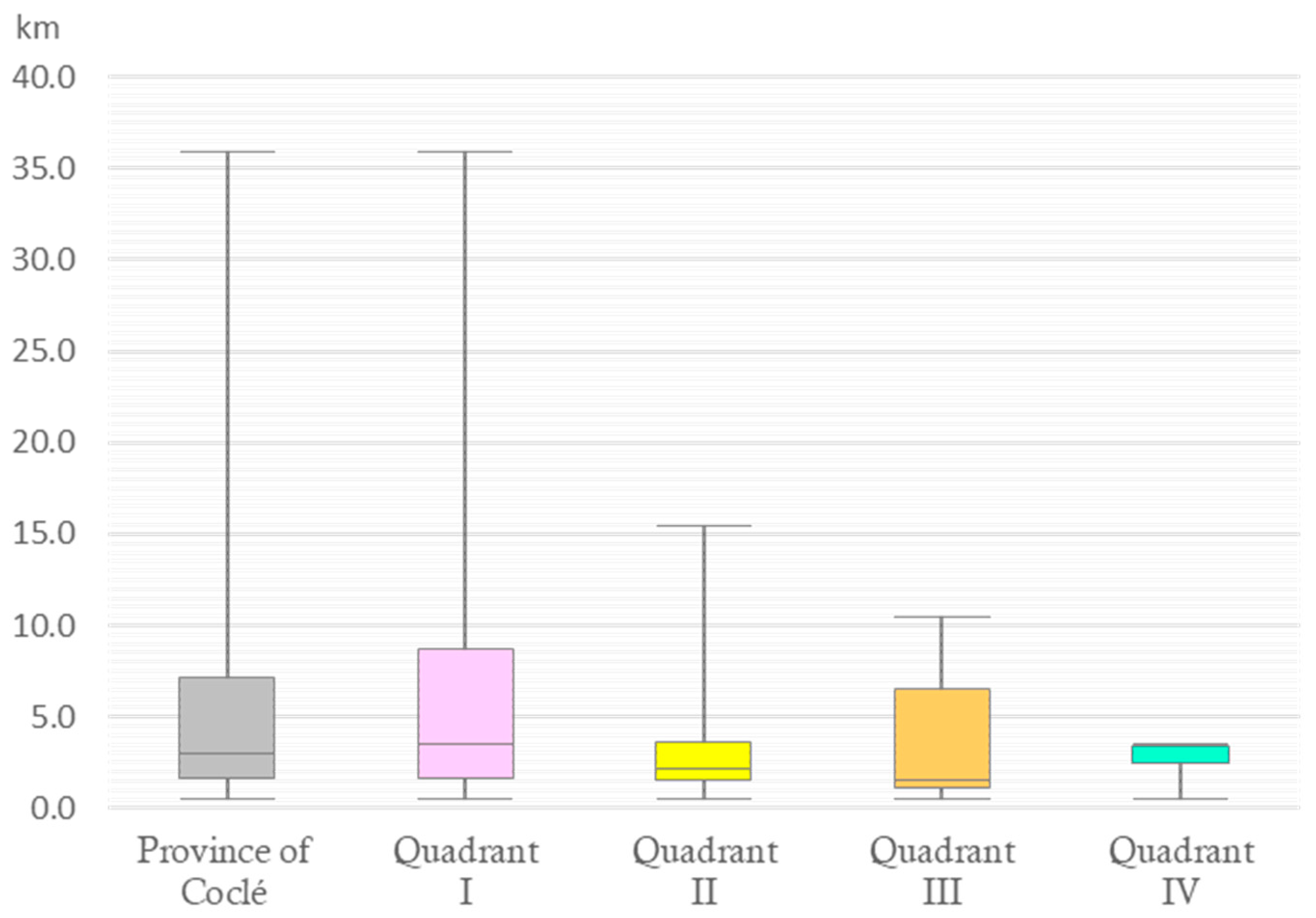
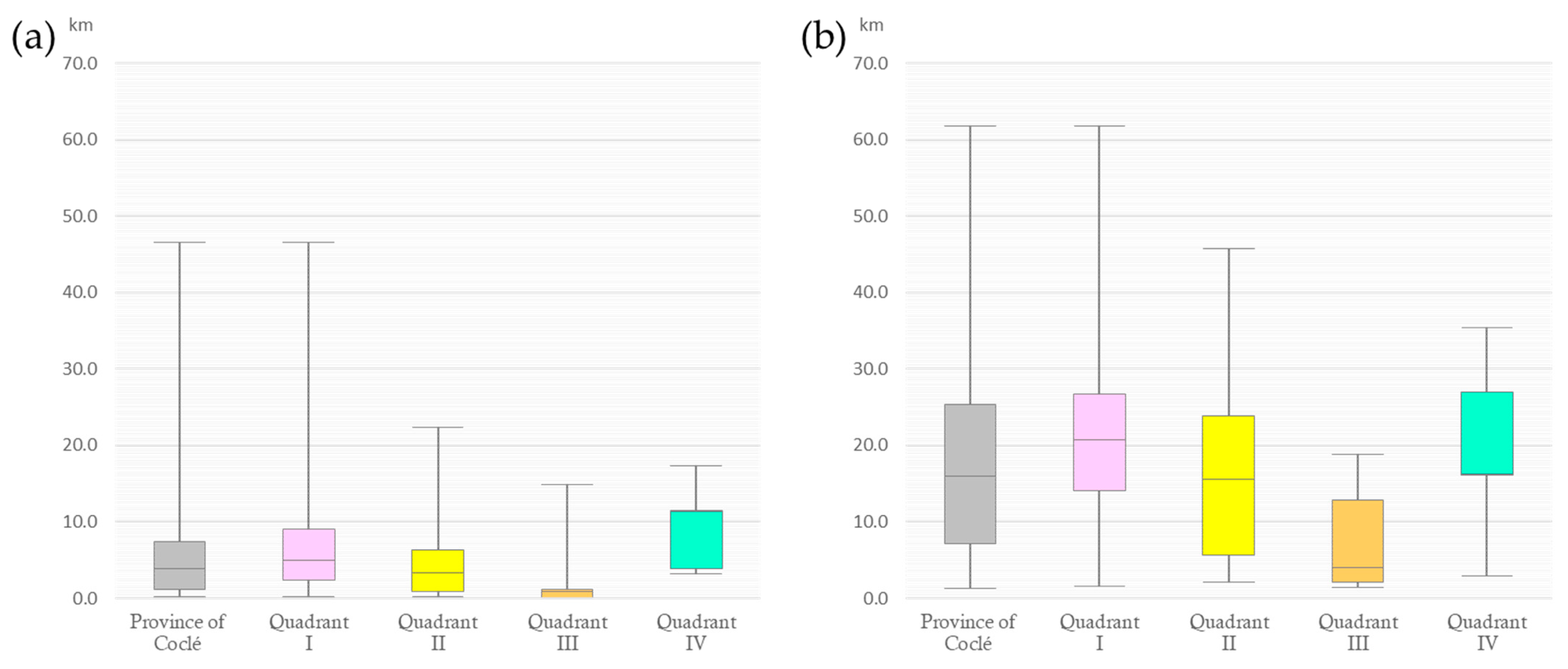
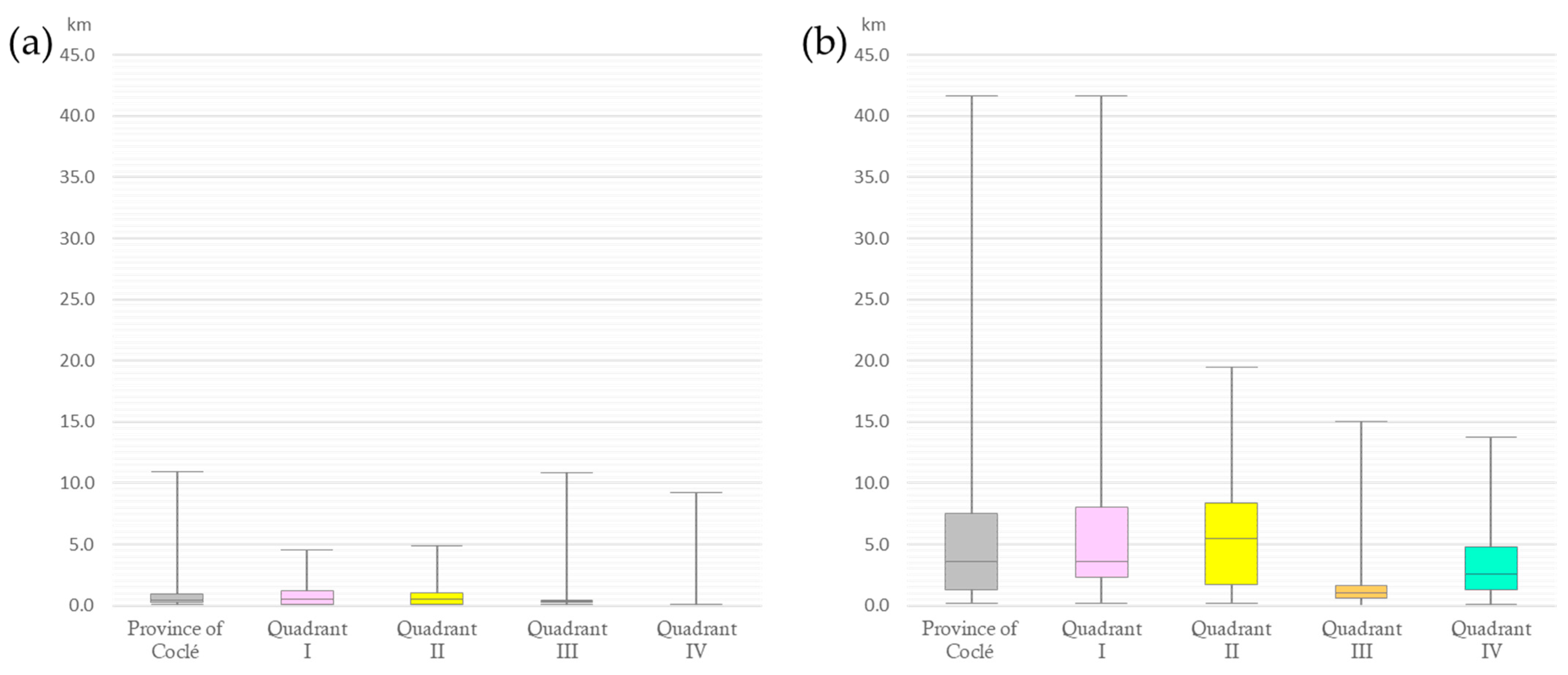
| Data | Units | Q1 | Q2 | Q3 | Q4 |
|---|---|---|---|---|---|
| Total Area | km2 | 2230.5 | 1779.3 | 620.7 | 310.3 |
| Towns 1 | Number of towns | 598 | 556 | 52 | 33 |
| Population 1 | People | 116,459 | 72,994 | 40,972 | 16,253 |
| Density 1 | People per km | 52.2 | 41.02 | 66.0 | 52.4 |
| Data | Units | Q1 | Q2 | Q3 | Q4 |
|---|---|---|---|---|---|
| Paved Roads | km | 511.5 | 531.2 | 246.7 | 207.9 |
| Unpaved Roads | km | 2692.0 | 2053.7 | 727.9 | 340.2 |
| Nodes | - | 65 | 60 | 19 | 25 |
| Kilometers per nodes | km | 8.5 | 9.4 | 14.5 | 9.9 |
Disclaimer/Publisher’s Note: The statements, opinions and data contained in all publications are solely those of the individual author(s) and contributor(s) and not of MDPI and/or the editor(s). MDPI and/or the editor(s) disclaim responsibility for any injury to people or property resulting from any ideas, methods, instructions or products referred to in the content. |
© 2023 by the authors. Licensee MDPI, Basel, Switzerland. This article is an open access article distributed under the terms and conditions of the Creative Commons Attribution (CC BY) license (https://creativecommons.org/licenses/by/4.0/).
Share and Cite
Quijada-Alarcón, J.; Rodríguez-Rodríguez, R.; González-Cancelas, N.; Bethancourt-Lasso, G. Spatial Analysis of Territorial Connectivity and Accessibility in the Province of Coclé in Panama. Sustainability 2023, 15, 11500. https://doi.org/10.3390/su151511500
Quijada-Alarcón J, Rodríguez-Rodríguez R, González-Cancelas N, Bethancourt-Lasso G. Spatial Analysis of Territorial Connectivity and Accessibility in the Province of Coclé in Panama. Sustainability. 2023; 15(15):11500. https://doi.org/10.3390/su151511500
Chicago/Turabian StyleQuijada-Alarcón, Jorge, Roberto Rodríguez-Rodríguez, Nicoletta González-Cancelas, and Gabriel Bethancourt-Lasso. 2023. "Spatial Analysis of Territorial Connectivity and Accessibility in the Province of Coclé in Panama" Sustainability 15, no. 15: 11500. https://doi.org/10.3390/su151511500
APA StyleQuijada-Alarcón, J., Rodríguez-Rodríguez, R., González-Cancelas, N., & Bethancourt-Lasso, G. (2023). Spatial Analysis of Territorial Connectivity and Accessibility in the Province of Coclé in Panama. Sustainability, 15(15), 11500. https://doi.org/10.3390/su151511500






